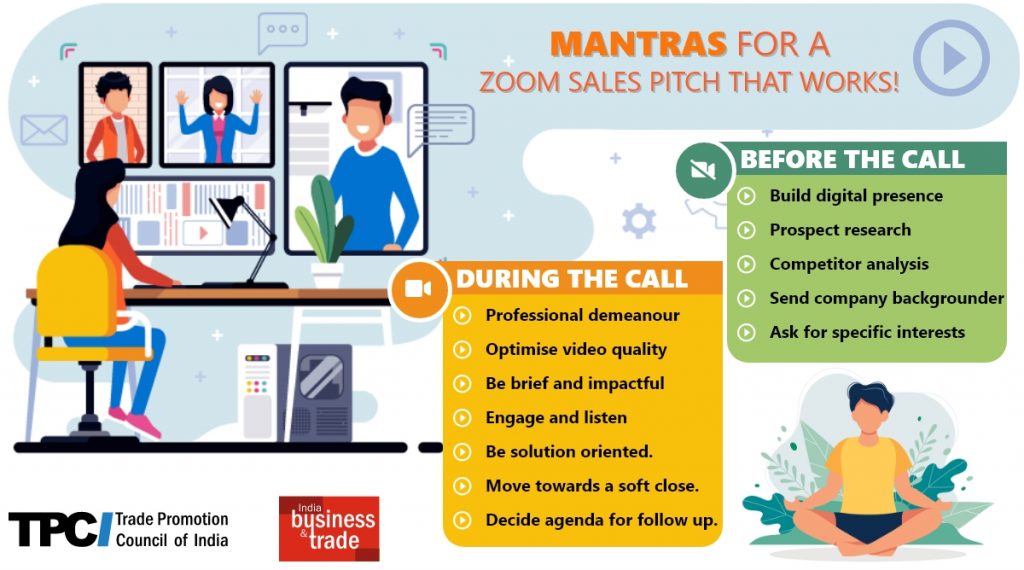Lights, video, action! How to ace the Zoom sales call
Video calling appears to have eliminated all possible barriers of distance for sales teams, besides saving time, energy and costs associated with travelling. But companies need to be careful about how their salespeople approach the Zoom sales call.
- COVID-19 pandemic has accelerated the use of video conferencing as a tool for businesses to engage with multiple stakeholders.
- In April 2020 alone, Zoom recorded 300 million daily meetings as compared to 10 million in December 2019. Juniper Research has estimated that the number of mobile video calls during the pandemic rose by 50% to 1.8 billion globally in 2020.
- When you are looking to engage with your clients, video calling appears to have transcended all possible barriers of distance, besides saving time and costs associated with travelling. However, companies need to be very careful about how their salespeople approach Zoom meetings.
- This blog provides some guidelines on how to effectively manage your sales process through a Zoom meeting in this brave, new and unabashedly digital world.

Photo by Julia M Cameron from Pexels
The COVID-19 pandemic initially confined millions of citizens to their homes. Even as governments progressively lifted lockdowns, international mobility continues to be limited and highly conditional with strict checks and balances.
Over this period, companies have aggressively leveraged video conferencing as a vital tool to communicating with their stakeholders and ensure the least possible disruption in business. In April 2020 alone, Zoom recorded 300 million daily meetings as compared to 10 million in December 2019. Juniper Research has estimated that the number of mobile video calls during the pandemic rose by 50% to 1.8 billion globally in 2020. The number of users on mobile video calling platforms is expected to reach 4.5 billion by 2025.
Communication in the video space
The history of people-to-people communication is as old as the origin of speech itself, estimated to date back to around 500,000 BC. People have progressively evolved in terms of their modes & channels of communicating with each other, but the past few decades have been truly phenomenal. Just like we are coping with a surplus of information, people are now inundated with a surplus of communication channels thanks to technology – calling, SMS, email, instant messaging, social media, video sharing, and now video calling/conferencing.
When you are looking to engage with your clients, video calling appears to have transcended all possible barriers of distance (to be bettered by teleportation perhaps!). But it is important to understand that while it is as close you can get to a physical handshake at present, it is not exactly the same thing. Moreover, there is a visible fatigue in people when it comes to spending time on the screen. This blog lists some of the key pointers you need to keep in mind while making a presentation to the client via the online medium.
Insist on face time
Experts have opined in various studies that around 70-90% of communication is non-verbal. This includes body language, facial expressions, postures, eye contact, physical appearance, head movements, hand gestures, etc. These can tell you a lot about the actual interest of the client in your presentation. Eye-to-eye contact, for instance, conveys engagement of the client in the conversation. Even for salespeople, face-to-face communication is a better way to show conviction and build credibility and trust. Therefore, it is important to insist that clients keep their video switched on during a call to the extent possible, and keep yours on as well.
While camera angle, noises, background, people moving around, lighting, etc may seem like small details, they can be needless distractions that show a lack of seriousness as well. Therefore, they are best avoided.
Content marketing
In the limited time you have with your prospective client, leverage the use of rich online communication tools like video, infographics, datasheets, case studies, etc to showcase your products and services to the customer. On the other hand, do not spend too much time in generic information about your company that you can also share separately via email.
In fact, it would be a good idea to share relevant content resources with the client in advance, so that they have a context before the meeting itself. In this regard, having a strong digital presence, be it through content on your website or through various social media channels can work wonders in creating a positive image for your brand. It is an unavoidable reality for business today. While investing in building a digital brand comes at a cost, it also comes with disproportionately higher returns in the long run. Prof D V R Seshadri, Director for ISB-CBM and Clinical Professor in the Marketing Area, Indian School of Business, opines:
The online medium has given businesses an opportunity to rethink how they work and engage with their customers in a more meaningful way… Online marketing isn’t just about sales, it’s about building relationships, offering experiences, and creating trust.
You can also use this as an opportunity to know the prospect’s needs better, and ask them a leading question like, “Are there any specific areas of interest that you would like me to cover in our meeting?” It may not elicit a response, but if it does, it gives you much better context and headway going into the call.
Listening
Clearly observe and ascertain the specific product offerings of your company that gain the interest of your client. This can be done by asking them leading questions and more importantly, understanding the core pain points that they presently have.

‘The gift of the gab’ was traditionally considered the expressway to royalty in the sales field. But empathy and two-way communication are now known to be critical attributes. Stressing or pushing the customer too much (overselling) may derail the sales process, especially as customers have developed a natural resistance against the ‘push’ approach.
Understandably, the salesperson has the pressure of a target on his/her mind, but you will actually sell best when you ‘genuinely’ keep the customer’s needs first. The true benefits of this approach are seen not just in the immediate sale, but also few years down the line when you built strong customer relationships that are professionally & personally rewarding.
Closing and Follow up
Let’s be clear – the Zoom call, just like the other elements of a sales process, has to be focussed and objective-driven. Unless the context and nature of the next steps to the engagement are not clear, an email may just end up being another piece of irrelevant information in the client’s inbox. At times sales managers send some of their juniors to make the Zoom call to just get introduced, make some generic presentation and seek a further time for discussion with the sales manager himself/herself. That is best avoided, as it shows you do not respect the client’s time. Better to reschedule and be present yourself.
In fact, you should move towards a soft closing during the presentation itself. Ask them by when would they be willing to book an initial order, quantity/package they are looking for, pricing, and also if you could send them some samples (which will also indicate their interest and gives you an avenue for continued engagement). Even a rejection by the client is a positive in the sales process, as it provides you an opportunity to know their exact concerns/constraints.
When closing the call, it is a good idea to summarise the discussion, reiterating what you have learnt about the client’s business and pain areas, besides the mutually agreed course of action going forward. As a general thumb rule, you should follow up within 24 to 48 hours of the Zoom meeting on the next steps.
I would strongly recommend that sales leaders take the Zoom call very seriously; i.e. ensure that it is purpose driven and your teams are well trained to execute them. Sometimes, it is observed that they are delegated to executives who are just meant to give general information and take down contact details of the client for further discussion. In the absence of a physical meeting, they are invaluable opportunities to not just create a connection, but also to make a strong impact and differentiate your offering from the competition. Therefore, they need to be valued from that perspective.
Finally, as and when the pandemic recedes, companies have to be more careful about how they use this tool. While the current times have made video calling an integral part of business across the world, these services were ubiquitous in Europe and North America even prior to the pandemic. When the pandemic lifts, people and organisations would be obviously wiser from the experience of video calling. At that juncture, they can make a more educated choice on whether they want to continue communicating on the back of internet bandwidth, or return to the traditional physical handshake.
The best solution, of course, is a combination of the two. For a salesperson looking to cover more meetings a day across locations, for instance, a video call is a viable alternative, in some cases, to the sheer exhaustion and time wastage when it comes to physical travel. When your clients are international, there is a huge added element of cost to it as well. In the remote working paradigm, video conferencing is a blessing when it comes to collaborating with teams.
But on the other hand, if you want to do a committed deep dive into market trends, consumer behaviour, emerging technologies, new competition and network with a wide range of industry stakeholders, a video conference falls way short of a physical event. And if you are addressing a large audience, a webinar may not give you the same level of engagement as a townhall. Moreover, a video meeting should be seen more as a tool of convenience, not the route to building enduring company-client relationships.
Virat Bahri is Deputy Director, Media & Corporate Communications, Trade Promotion Council of India, and Editor, India Business & Trade. Views are personal.













Leave a comment